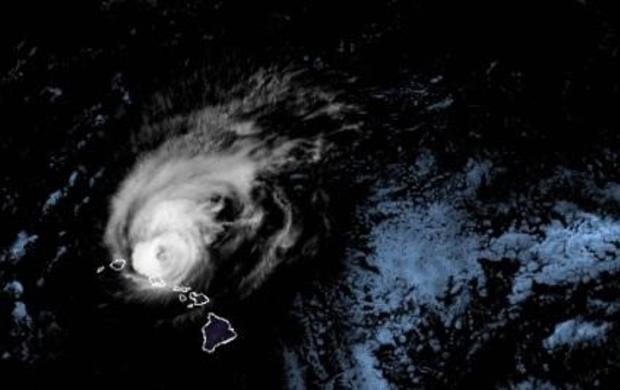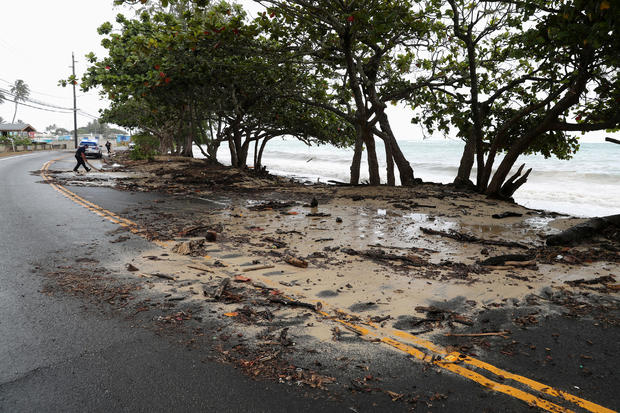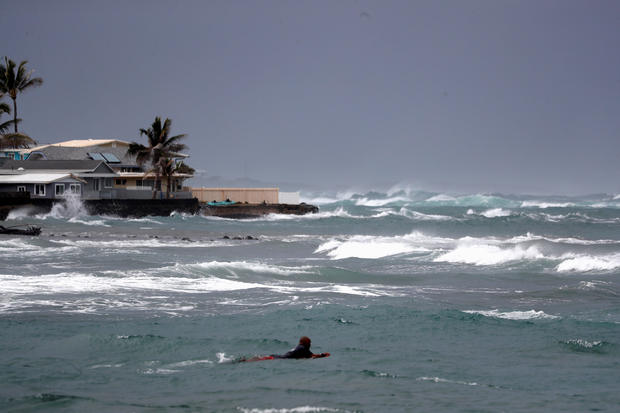Hawaii apparently escapes worst of Douglas’ wrath — barely
Honolulu — Hurricane Douglas came within a “razor thin” distance of the Hawaiian Islands but spared the state the worst of the strong winds, storm surge and flooding officials had warned about.
Meteorologists cautioned the hurricane’s path could shift slightly and Douglas could still unload its destructive power on the islands of Oahu and Kauai.
“It’s still not out of the realm of possibilities. So we want people to really remain vigilant and stay prepared, at least for tonight,” Eric Lau, a meteorologist with the National Weather Service in Honolulu said Sunday.
As of 8 p.m. Hawaii Standard Time (2 a.m. EDT), Douglas was 60 miles north of Honolulu and scurrying west/northwest at 16 mph. It had maximum sustained winds of 85 mph, making it a Category 1 hurricane, according to the Central Pacific Hurricane Center in Honolulu.
The center said, “Gradual weakening is forecast during the next 48 hours, but Douglas is expected to remain a hurricane as it moves near Kauai later tonight.
” … Total rain accumulations of 3 to 6 inches with locally higher amounts are possible, with the greatest rainfall in elevated terrain. This rain may result in flash flooding and land slides, as well as rapid water level rises on small streams.”
Heavy rain and wind gusts battered Maui Sunday morning, downing a small tree on the Hana Highway.
Gentle rain fell and blustery winds swayed trees on Oahu, home to the state’s biggest city, Honolulu. Sand and debris washed ashore on a two-lane coastal road.
Despite the dangers, surfers rode waves and residents took selfies at a lookout point next to the ocean.
Lau said Douglas would have been a lot worse had its track been 20 or 30 miles farther south.
One reason is that this path put Douglas to the north of the state and not directly over the islands. Another is that this path mostly put the island chain near the southwest quadrant of the storm, which is often less destructive than the northeast and the right side of a hurricane’s eye, Lau explained.
“We were really playing with a really fine line, a razor thin line between what we’ve experienced today compared to what we could have experienced,” he said.
Honolulu Mayor Kirk Caldwell warned Oahu wasn’t “out of the woods yet” and strong winds, heavy rains and flooding could still hit.
“We’re cautiously optimistic that we’ll be able to issue an all clear early tomorrow morning, but our city staff is continuing to monitor any effects this storm may have overnight,” he said in a statement.
Duke Stevens, who lives in Hana on Maui’s eastern tip, said by early afternoon there was no longer any wind and the light rain that fell persistently through the night had subsided. “I’ve seen a lot worse,” said Stevens, who has lived on Maui since 1987.
Antonia Hall, of Kihei, in west Maui, said the storm avoided her area, although she and others were prepared for the worst. “Maui has skirted so many hurricanes,” she said. “This is just kind of something we go through here.”
About 300 people evacuated to the Hawaii Convention Center on the edge of Waikiki. On Maui, 22 people were at five shelters around the island.
Evacuees were told to bring masks and hand sanitizer along with the usual emergency supplies of food and water. People will have to wear face coverings to be admitted, and will have to wear them unless they are eating, drinking or sleeping.
State health department officials contacted each of the 625 people who were currently in isolation or quarantine as of Friday because they are either COVID-19 positive or have been in contact with someone who is. Every one of those indicated they would shelter-in-place and not seek refuge at a hurricane shelter.
Hawaii has some of the lowest coronavirus infection rates in the nation, but COVID-19 numbers have been rising in recent weeks. For three consecutive days through Saturday, Hawaii reported record highs of newly confirmed cases.
President Trump issued an emergency declaration for Hawaii because of the hurricane, directing federal assistance to supplement state and local response efforts.
Hawaiian Airlines canceled all Sunday flights between Hawaii and the U.S. mainland and also between the islands.
Source: Read Full Article


